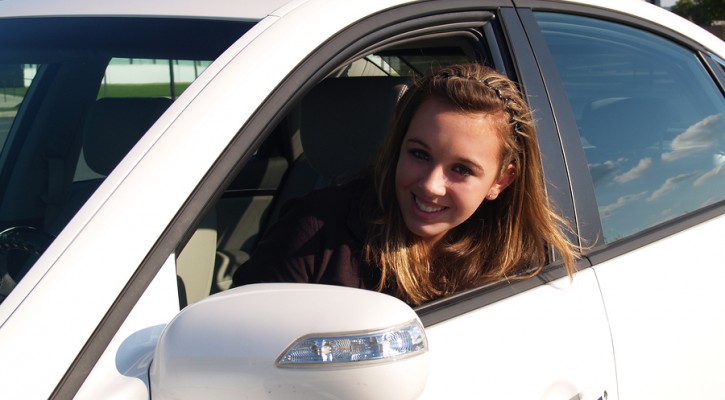Category Archive: Driving Skills
You Snooze, You Can Lose…Your Life
December 15, 2006
Did you know that if you are driving at 60mph, and you close your eyes for one second, your car would have traveled almost 90 feet? Yep, it’s a scary fact, and evidence that driving while tired is just as dangerous as drinking and driving. Thankfully, there is a website I just discovered that can help keep teens save while driving at night or in the early mornings, or anytime drowsiness is a problem.
If you visit www.thenonap.com, you’ll see they’re selling a gadget called No Nap. This is a little device fits behind your ear and senses when you become drowsy. To keep you from dosing off, it sounds an alarm to help keep you alert and awake.
No Nap will set you back $20, but that is well worth it, considering it can save your life. It’s even offered in three colors: grey, red, and yellow – so you can pick the color best suited to your personality.
As teenagers, we can use all the help we can get staying safe on the road. Fatal car accidents are the number one killer of teenagers, and falling asleep at the wheel is a big cause of car accidents. If your car can travel 90 feet in one second while going 60mph, think of what can happen if you nod off for only a few seconds. If you think you’ll wake up if your car drifts off the road, or if you’ll have time to react when you “come to,” think again. Products like the “No Nap” can help save your life.

Safety on the Road for Teens
November 15, 2006
As teens, we think we know it all, but we don’t. Based on the number of fatal accidents caused by teenage drivers each year, we don’t know some things – like how to drive safely. In “Driving Tips for Teens,” a video presentation that is offered by Allstate Foundation and its partners, there are some startling statistics. The one statistic about teens being 400% more likely to die in a car crash than someone who is in their mid-twenties to mid-thirties should really put a damper on your enthusiasm to go joy-riding with some friends after school.
Luckily, there are a few things we can do to help avoid being a statistic. We’ve all heard the importance of avoiding aggressive drivers and getting out of their way, or defensive driving. We also know that we should buckle our seat belts, keep our hands on the wheel (at all times!), and not talk on cell phones, eat or drink while driving. However, many teens are still doing this. It is also very important to mind the speed limit at all times – they really are there for a reason!
One of the most important things for all drivers to remember is to never drink and drive. Drinking impairs our ability to think straight, and for a teenager or other young, experienced driver, this can spell disaster. Distraction and a reduced ability to react are recipes for a fatal accident. This is another reason why it is never recommended to drive while you’re angry. When your emotions are so strong, your mind is distracted.
The site also mentions a driving program called TeenSmart. It helps parents of teen drivers work with their kids in meeting all the state driver’s licensing requirements without the heated discussions and arguments. There is also cool video and computer based training sessions that teenagers can take that puts us through the paces of what we would likely encounter on the roads. This is just another great tool to help teenagers get experience, increase their skills, and gain additional driving privileges – especially while they are practicing for their driver’s license test.

Teen Driving Fatalities During After School Hours
October 31, 2006
Listen up, parents. If you were worried about teenagers driving on the weekend nights with their friends, you’ll have new reasons to monitor teen driving after reading a recent press release by AAA. According to new research, teens are just about as likely to get into fatal accidents while driving during after school hours.
Teen drivers had 1,237 fatal accidents between 2002 and 2005 when driving on Friday and Saturday nights. But, what’s surprising is that there were almost just as many fatal accidents for weekdays between 3 and 5 p.m. – 1,100 in total. That means they’re not much safer being limited to driving to and from school each day.
What can you do to help your teen driver avoid a fatal accident? Here are a few suggestions giving by AAA that may help save your teens life.
- While most states have laws that limit the number of passengers a new teen driver may have, make sure this law is a family rule. The more passengers a new driver has, the more likely they are to be involved in an accident.
- Keep your teen from using the cell phone while driving, even the hands-free type. Even an experienced adult driver has trouble driving while talking on the phone.
- Make sure your teen uses their seatbelt each time they ride in the car. Though teens feel invincible, we certainly are not. Teens have the highest crash rates, but yet the lowest rates of seatbelt usage.
- Finally, make sure other adults in the family know the ground rules set. Tell the parents of your teen’s friends, or even your neighbors. If everyone keeps an eye on your teen’s driving habits, they are less likely to bend the rules and put themselves at a greater risk of a fatal accident.
If there are laws in your state limiting the hours your teen may drive, or the number of passengers they may carry while they are new to driving, you may feel your teen is much safer than others are. However, laws are still broken, so always monitor your teens driving and keep the ground rules firm. For more information, read the Department of Highway Safety and Motor Vehicles Driver Education Handbook for Parents.
Parents and Teens Both Get into the Safe Driving Groove
September 11, 2006
It is every teen’s dream to get that learner’s permit in their hand. After all, driving equates to freedom, doesn’t it? But let’s face it teenagers, we don’t know everything there is to know about driving a car. Did you know that car crashes are the leading cause of death in our age bracket? That’s a pretty scary thought!
The recent article in the Cincinnati Post about teen drivers is sort of eye-opening. Sure, we know to buckle our seat belts and make sure to use our turn signals and such. But who is going to really teach us about what to do if our brakes lock or how to get out of a dangerous skid? That is not exactly something our parents could or know how to teach us.
Yeah, they preach to us about safety on the road and tell us in theory how to get out of a dangerous driving situation, but until we actually experience it, all that talk is in one ear and out the other right? We humor the parents and we lead ourselves into a false sense of security. We think that those crashes will never happen to us. But the reality of it all is that we COULD be that next crash just waiting to happen.
Car manufacturer Toyota came up with a great driving awareness program called “Toyota Driving Expectations.” The catch is that we teenagers have to take the class with our parents! Now before all the grumbling starts, this class is quite an eye-opener for both us and the “adults.” They get put through their paces just as much as we do.
Each of us gets to experience our own driving courses; parents have different distractions thrown at them like ringing cell phones and fiddling with the radio, things we all do every day. Teenagers get to learn some defensive maneuvers and how to avoid crashes. Believe it or not, it’s interesting and fun to experience this stuff with your parents. We all learn something and have a better respect for each other’s driving abilities. And guess what? Parents will feel a little more secure and willing to let you drive!
Be sure to talk with them about the “Toyota Driving Expectations” program and visit the website at Toyota Teen Drive 365 to see if there is a class near you.
According to new scientific studies, the area of the brain that controls impulsive behavior doesn’t reach maturity until the age of 25. This has caused many people to reconsider the age that teens should be allowed to drive. Currently, many states allow teens as young as 16 the right to drive. However, statistics have proved that 16 year olds are dangerous drivers, have the highest auto related death rates, and more teens die while riding in vehicles driven by 16 year olds. What is interesting is that even though many parents and politicians feel that 16 is too young to drive, there is a certain degree of hesitancy when it comes to changing existing laws.
Some people look to the fact that many parents are tired of chaperoning their teens and look forward to the day when they can manage some of the responsibility of transportation themselves. But, ask any parent who has lost a child in a teen related auto crash, and they will quickly tell you that they would gladly chauffer their teen if it meant having their child back in their lives again.
Nearly all states have implemented changes that affect the way teens drive. Some of these changes include limiting the amount of passengers teens may have in the vehicle or decreasing the amount of time teens can drive alone. Nevertheless, though these rules have been put in place to help keep teens safe, they are frequently not enforced.
There is often a misconception behind the reasons why teens are involved in so many fatal crashes. The fatal crashes are often mistakenly blamed on alcohol or drugs. However, as current studies have shown, it is a matter of brain maturity, and not excessive teen drinking that contributes to the high rate of deaths associated with teen drivers.
When people put pressure on politicians to raise the drinking age, changes were made that ensured the drinking age would be 21. This has been a positive change that has undoubtedly saved many lives. Unfortunately, it seems that it may take more fatal crashes before politicians realize that the best way to protect teens from the dangers of driving is to similarly raise the driving age.
Read more driver education news in the Safe Driving Teen Monthly Bulletin. Each month the National Safety Commission publishes the bulletin for teens and parents designed to improve teen driver behavior, attitude, skills, and experience. Subscription Details

Is 16 Too Young to Drive?
August 28, 2006
On an average day in the USA, 10 teenagers are killed in teen-driven vehicles. This has caused many officials to question what age teens should be allowed to drive. OK- are you ready from some scary statistics? USA Today studied deadly crashes that took place during the year 2003. Of those accidents that involved drivers between the ages of 16-19, more people died throughout that year then for any disease or teen related injury. Are you ready for the numbers, how about 3,500 teenagers? That’s right, 3,500 teenagers died during the year 2003 from driver related accidents in teen driven vehicles. The statistics are frightening, and have caused many people to ask if teens really are ready to drive. Well, now it seems that science may be answering that question.
New scientific research has shown that the part of the brain that helps control impulsive behavior and helps rationalize the cause and effect of such behavior doesn’t fully develop until roughly the age of 25. You know how everyone says that teens believe they are immortal? Well, according to these studies, it’s true. But the reality is that we aren’t. And it is sad to say, but 3,500 teens in 2003 proved that they weren’t. So what are we to do?
Another point that the statistics show is that 16 year olds are involved in more fatal accidents and are worse drivers than all other teen drivers. In fact, states like New Jersey that restrict 16 year olds from driving have the lowest teen death rates in the entire country. There are a number of different reasons that make 16 year olds unsafe drivers and increase their chances of being involved in a fatal car crash. Some of these include:
- Sixteen year olds are inexperienced drivers. Many parts of the country, such as the South have unsafe streets, even for the most experienced drivers. Teens don’t have the skills to drive on these rural roads.
- Teens often drive vehicles that are prone to roll. SUVs, pickup trucks, and small cars top the list.
- Teens often drive after dark and with other teens in the car. This can cause serious distractions and make it difficult to use all of the senses needed to be a safe driver.
- Alcohol and speeding plays a vital role in many fatalities.
No matter how old you are you should take these things into consideration and drive safely and carefully. If you don’t feel comfortable, then don’t drive. Never drink and drive, don’t drive after dark, and stay away from unsafe roads. Also, limit the number of passengers that you allow in the car with you. Your life is more important than your popularity. Sure, if you are killed in a teen driven car crash your name will be in the paper, your friends, family members, even strangers will come to your funeral and remember you, and your school may hold a day of remembrance in your honor, but is that really the kind of popularity that you want? Play it safe and smart and use good judgment when driving.
